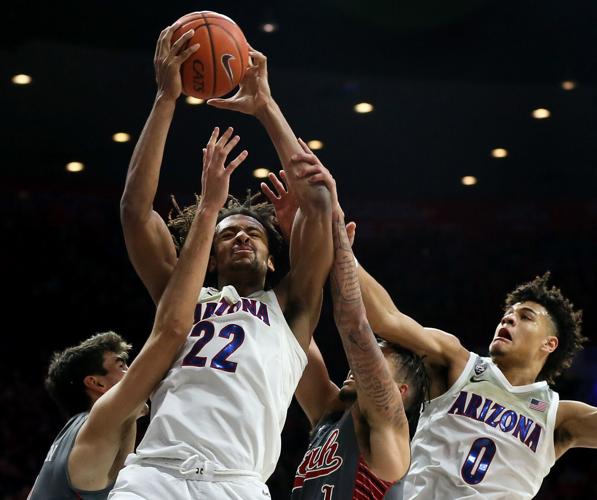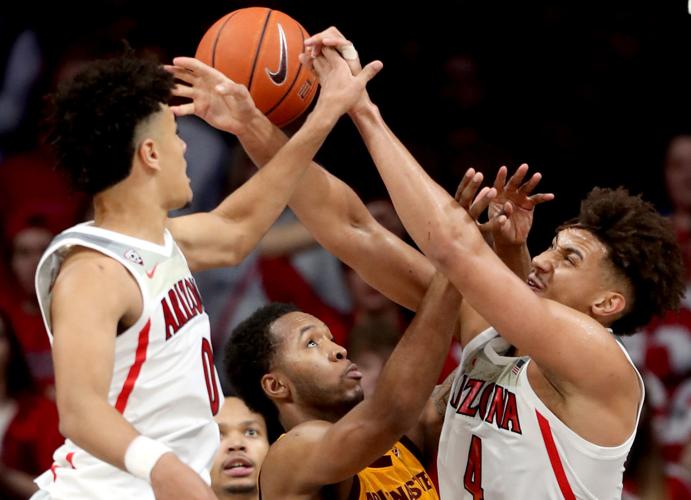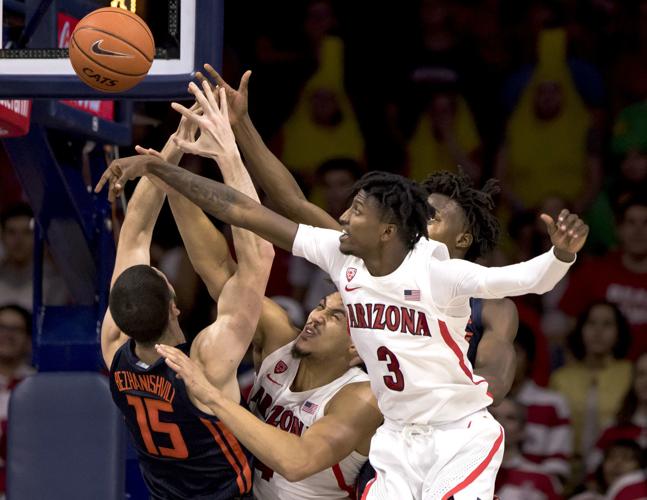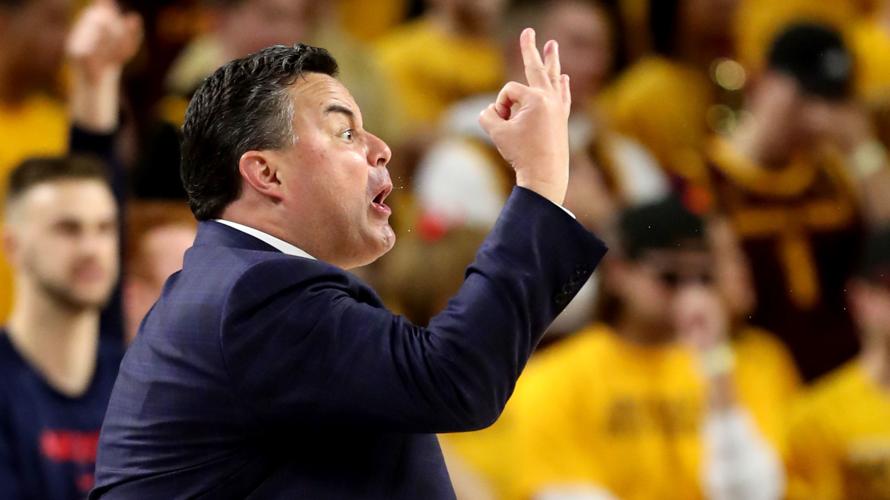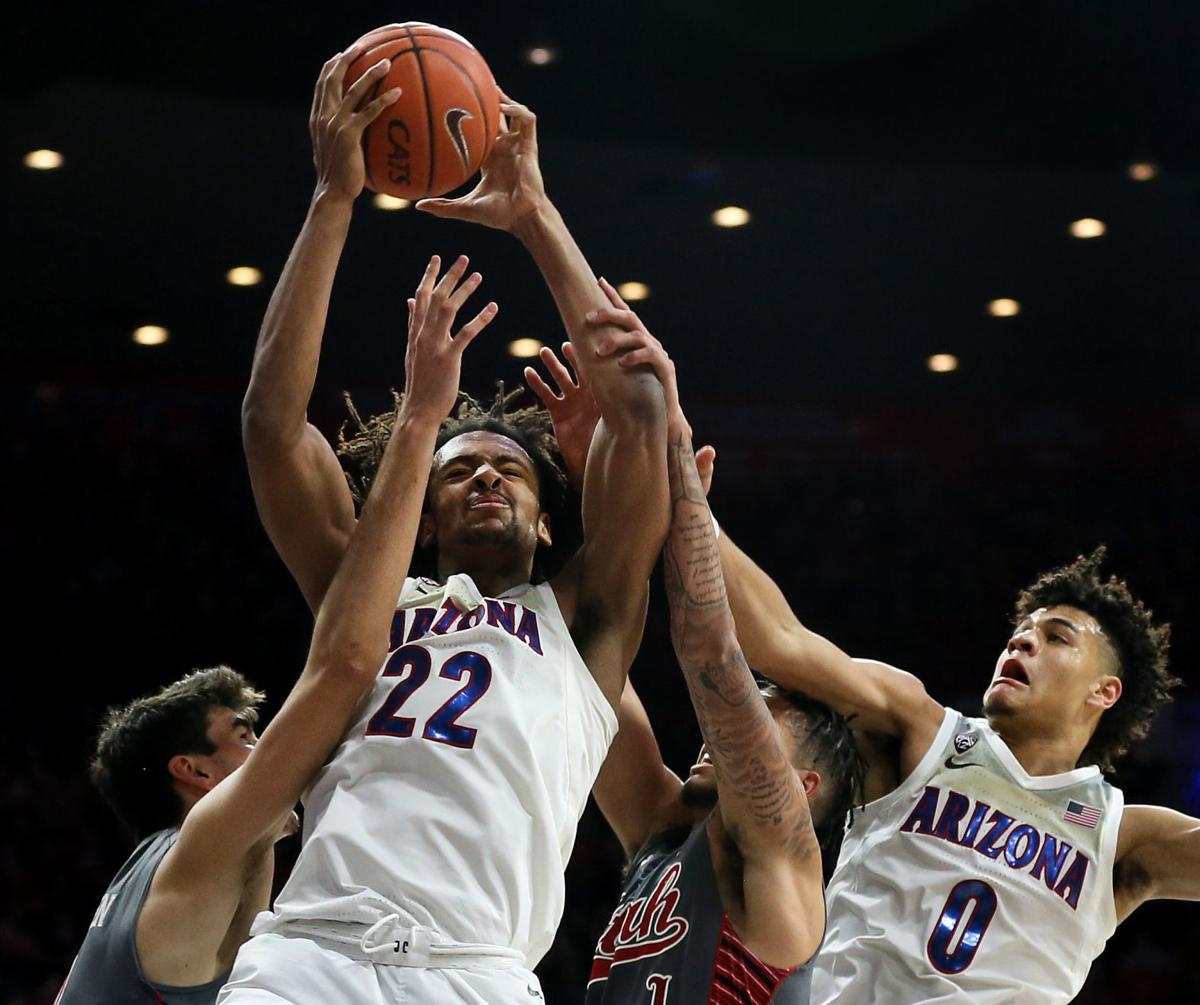When Arizona swept Washington and Washington State last week despite shooting less than 40% in each game, it didn’t require going far into the weeds to figure out why.
But they are still weeds. So there’s nothing glamorous, flashy or dramatically interesting about one of those reasons.
Yes, we are talking about rebounding.
“I know it’s not fun to talk about turnovers and rebounding,” UA coach Sean Miller said earlier this week. “But for our team, when we rebound the ball … and we really take care of the ball, that’s when we’re at our best.”
Arizona has actually been a pretty good ballhandling team all season, so it wasn’t a real surprise it had just 12 turnovers over its final 76 minutes of play last weekend, following a four-turnover initial segment against Washington on Thursday.
But Arizona has shown slight improvement on the glass in Pac-12 play, and it showed in Washington. Arizona outrebounded UW only by one and allowed Huskies center Isaiah Stewart to grab 11 rebounds. But Stewart had only one offensive board and Washington had just five others on that end, scoring just six second-chance points off them.
Things were even better for the Wildcats at Washington State. There, the UA outrebounded the Cougars 49-36 and held WSU to just five offensive rebounds despite 34 misses.
Coming up with that sort of success again this week could be the difference in Arizona’s games with USC on Thursday and UCLA on Saturday.
The Bruins and Trojans are Nos. 1 and 2 respectively in offensive rebounding percentage per Kenpom.com, a big reason why the Trojans are in the first-place loss column tie with Arizona and three other teams, and why UCLA has suddenly surged in recent weeks under first-year coach Mick Cronin.
“If you’re following our team right now, you see that we are rebounding better on defense, keeping the other teams from getting second shots and that’s a big deal,” Miller said. “That’s hurt us in some of our losses, and I don’t think there’s two opponents that do that any better than USC and UCLA.
“They depend a lot on second shots. I think both teams are at their best when they rebound really well; they emphasize it. They have talent in that area, and that’ll be a test that we have to pass, if we’re going to be successful.”
Here are a few reasons why the Wildcats have been improving on the glass:
1. Their coach just keeps harping on it, through the media and (probably) also behind closed doors.

Arizona head coach Sean Miller calls in his defense against Arizona State in the first half of their Pac-12 game at the Desert Financial Arena, January 25, 2020 Tempe, Ariz.
Back in December, Miller started repeatedly called rebounding the Wildcats’ “Achilles’ heel,” and he’s constantly preached about the importance of keeping opponents from getting second shots — or defensive rebounding.
Miller took it a step further after UA’s 93-77 win over Utah on Jan. 14 when addressing how Stone Gettings had done well in many areas, even picking up two offensive boards, but had no defensive rebounds.
“That’s kind of the carbon monoxide stat,” Miller said. “You don’t see it but it’s killing your team. He played 28 minutes and one thing he didn’t do is get a defensive rebound. You can’t win in college basketball if you give teams second shots.”
2. The guards are helping more.

Arizona Wildcats guard Dylan Smith (3), Illinois Fighting Illini forward Benjamin Bosmans-Verdonk (13), and Arizona Wildcats center Chase Jeter (4) fight for a rebound during Arizona Wildcats 90-69 win over the Illinois Fighting Illini at McKale Center on November 10th, 2019.
While starting center Zeke Nnaji has been by far the Wildcats’ best and constantly improving rebounder, guards Nico Mannion (1.9 rebounds in nonconference play versus 3.9 in Pac-12 play) and Dylan Smith (2.2 to 3.3) have also made improvements in Pac-12 play. Unfortunately for Arizona, Josh Green’s average rebounding dropped from 5.1 in nonconference play to just 3.8 against Pac-12 competition.
“We need everybody to participate,” Miller said. “When the (opponents’) shot goes up, it’s not having three players try to get the ball, but having five. That’s easier said than done, but if you think of Kadeem Allen or T.J. (McConnell), those types of players weren’t big guys, but in certain games they got some really big rebounds. It doesn’t just fall on our post players.”
3. They’re tougher.

Arizona’s Josh Green, left, and Chase Jeter get tangled up with Arizona State’s Kimani Lawrence while trying to control a rebound in their Jan. 4 game at McKale Center.
Assuming players are evenly matched physically and in judging the angles of how the ball might bounce off the glass, much of rebounding success simply comes down to focus, toughness and determination.
Miller says the Wildcats have improved in blocking out and being physical against opponents in rebounding, and the insertion of Gettings into the Wildcats’ starting lineup may also have helped. Gettings averaged just 2.5 rebounds a game in nonconference play before he missed a month with his Nov. 28 injury, but is averaging 4.3 so far in Pac-10 games — including 12 at WSU.
“When you’ve got me, Josh and Zeke at the 3-4-5 to start, it makes it really hard on the other team to keep getting defensive rebounds when we’re all kind of running in there,” Gettings said. “We’re all really strong. I think me and Zeke hit 19 on NBA bench (a measure of how many times players can bench press 185 pounds) earlier in the year, and Josh is strong as a bull.”
But can they sustain it, no matter who is in the lineup, against USC and UCLA?
There may be no bigger concern on Miller’s mind this week, judging by how he discussed it during his news conference Tuesday.
“As a team, we have to do a great job of making sure that we finish the possession and block out, and be physical,” Miller said. “We work on it, but just because you work on it doesn’t mean that it carries into a game. It really falls on the players.
“Our team has done a really good job of embracing that and improving, but that can go away quickly. I think the biggest challenge yet is this week. If we don’t rebound well, it’ll be a really tough task for our group.”


